

The Rieger Organ of the Scots' Church, Melbourne, Australia
2015-07-03 - Sample Set SpotlightSeveral weeks ago, Dr. Csaba Huszty, founder and director of Inspired Acoustics, asked if I would like to review the organ of the New Scots' Church in Melbourne, Australia, one of IA's latest sample sets. I said that I would be pleased to, and that he could count on me to give a "positive but honest" review. By positive and honest, I meant that I am ALWAYS honest in my reviews. If there is something that I don't like about an instrument, I will say so. I am also always positive because my reviews are intended to highlight the features of the organ under consideration. I'm not here to condemn anything, and after all, it's just my opinion, isn't it?!? Also, all of us benefit by increased sales of sample sets. Increased sales means more and better sample sets can be produced, and, at lower costs to all of us! With this review, I'll be beginning my new reviewing approach by including a little "demo recital" to illustrate my points. So, now that I've said, all of that, let's take a look and listen to the Scots Memorial Organ by Inspired Acoustics!

The famous, Gothic-styled Scots' Church, Collins Street.
Before I saw anything, I will point out that there is a wonderful, four-part story about the Scots Memorial Church, it's history, the organ, and the recordings made for the sample sets on the Inspired Acoustics website, and I strongly commend it to your attention: http://www.inspiredacoustics.com/en Rather than try to "restate or recreate" what has already been more eloquently written, I will concentrate on the organ, it's characteristics, its strengths and weaknesses, as well as some of the possibilities that I found when studying the organ, and doing what I hope is a "widely varied" program for your listening attention.
The organ, considered by many to be the finest church organ in Australia was built by the Rieger Orgelbau, an Austrian firm of organ builders, known generally as Rieger. The firm was founded by Franz Rieger, and from 1873 it was known as Rieger & Sohne, and from 1879 as Gebruder Rieger, after his sons took over. At the end of World War II, the firm was nationalised by the Czech government and merged with another workshop as Rieger-Kloss. The Rieger tradition was also continued by the owners and workers of the original firm, who moved to Austria and founded a new workshop as 'Rieger Orgelbau'. The first pipe organ at Scots' was built in 1883 by Hill and Son. It was rebuilt and enlarged in 1910 by George Fincham and Sons and rebuilt again in 1959. The organ was removed for storage in 1999. The present organ was built in 1998 by Rieger Orgelbau, Schwarzach, Austria.
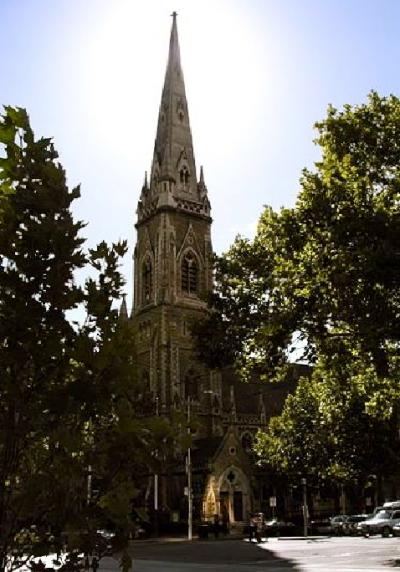
When an organist looks at a big church building for the first time, and usually from the outside, what is the first thing you think of? If you are like me, you say: "I wonder what the acoustics are like. I bet this place has a LOT of echo!" Well, you'd certainly think that if you look at the exterior of the Scots Church. Unfortunately, it doesn't. It's "dry" inside. Very dry. Not dead, but still dry.
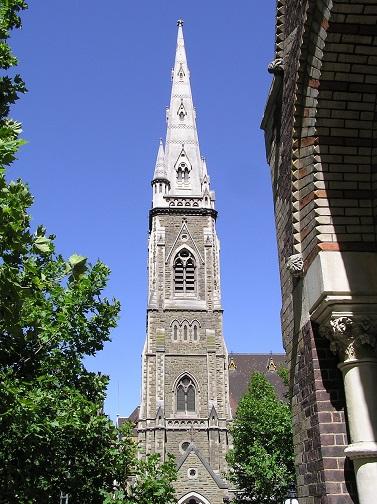
The massive Scots' tower is graceful and imposing.
As we walk along down Collins Street, we'd love to go inside and take a look around. Maybe we can hear, or even play the organ! Is it open? Yes, it is, so, let's go inside! We look down the long nave and our eyes search for the most important piece of "furniture" in the place - THE ORGAN! We look, but we don't see it. Surely a church like this MUST have an organ, but WHERE is it? So, we begin to walk down the aisle, on the beautiful and royal-looking CARPET, and, as we come forward, we look into the left transept (the "cross arm" of the traditional cruciform - or "cross-like" design of the building), and BOOM! There it is - and it's a big one, with an imposing case!

Looking down the Nave from the rear gallery.
Now, by know, you should have noticed two problems with acoustics - the location of the instrument, and the best friend of all organists, Mr. Carpet. However, there is another one. Can you figure it out? Well, it's the location in the transept. It's sort of like it's positioned in "another room". In many locations, you'll have to hear the organ and the choir from "around the corner". Think of this example: you and a friend are in a big house. You are still in the hallway, but your friend is already in the living room. Your voice has to travel "around the corner", or, depending on the exact location of you and your friend, your voice may even have to carry "through" the wall to reach their ears.
This is the unfortunate situation of this big Rieger organ, which really IS a fine instrument!
Now, if we turn around, and look back down the center aisle to the rear of the building, we see that there is more of the organ in the rear. This is the Echo division, SO necessary for the leading of congregational hymns.
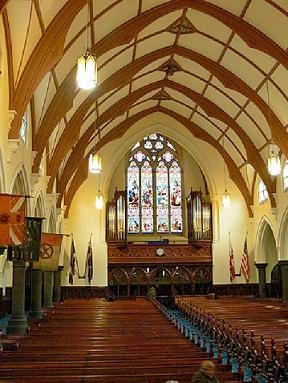
The Echo organ in the rear of the church,
We can't change the location of the instrument, and while we could hope that the church removes the carpet and seat cushions (not likely!), we could at least hope that the "soft" interior surfaces could be sealed with an acoustical paint. In the meantime, let's make the best of what we have, and judge the organ fairly and upon its own merits.
Before I proceed, I should say that I've always had a prejudice against Rieger organs. These ill feelings are really based on three things: 1) The chapel of my teacher's church had just gotten a new Rieger (1972-ish). It caused quite the stir in the area, as all the "tracker backers" praised it to the skies. Me? I hated it! Why? Well, for one thing, it had a flat pedalboard. I was a self-taught, barely music reading guy, who had (and still do!) a "unique" pedal technique, and the flat board was a nightmare to me. I didn't like the feeling of the "close" sound, the Positive hung on the gallery rail (Not knowing that this was the correct spot for it, I thought: "What idiot dreamt that up?!?") and the Trompette en chamade was directly over my head, looking like a brass machine gun! At this point, I knew virtually nothing, but I DID know that I wanted to play like Virgil Fox. The second thing I knew was that he would NEVER even play an organ like this "piece of junk!" I also had to play the "mighty Rieger" for 8 AM Holy Eucharist EVERY Sunday morning!
2) The second reason that I disliked Rieger organs was that Simon Preston had "forced" the installation of a new 4-manual Rieger during his tenure as Music Director at Christchurch, Oxford. The organ it replaced was a NOT very fine English one, but just the thought of playing Howells or Stanford on a "screeching whistle box" made my blood boil! Nothing could be worse than playing an organ like this one - unless it was a Flentrop... ;-) More about Christchurch, Oxford later.
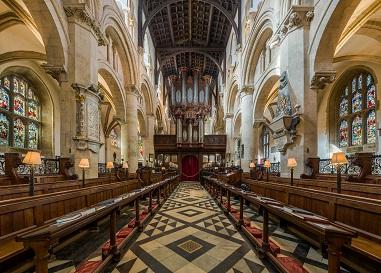
The Rieger organ at Christ Church Cathedral, Oxford.
3) The third reason is that, always having been unlucky about job appointments, when I came back from England, within a few months I had been named of a significant Episcopal parish in New York City. Having always been "unlucky" about jobs, this case was no different. The rector who hired me died with weeks of my starting there, and the new rector's first official act was to throw me out the door, and bring in a well-known woman, who had been his friend for years, as organist. She was married a very, VERY famous and controversial organist, and he was to be Artist-in-Residence. The church's struggling EM Skinner went out in the trash as well, and it was replaced by - a Rieger - that was the loudest organ I had ever heard, and had a special pedalboard that went down to "A" below "low C", as the artist in residence simply refused to play it unless it had that A...
So, know my prejudice against Rieger. With that in mind, let's begin our review...
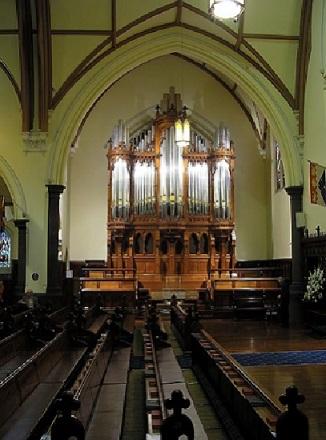
Looking at the organ standing directly under the central crossing.
This was my preferred listening spot.
There are 70 stops, and, as near as I can estimate, about 90 ranks. It's a very complete looking specification, with a French accent, and the manuals are arranged in the traditional French manner with the Great Organ at the bottom, followed by the Positive, the Swell, and the Echo at the top. The Swell and the Postive are under expression. Now, as much as I am a stickler for absolute authenticity, I "reversed" the position of the two expression shoes, keeping the Swell on the right, and the Positive on the left. There is a Walze (Crescendo pedal) which is not a pedal but a "roller", and this is found in the "traditional" location of the middle. I had hoped to give this a try, but as I generally avoid crescendo pedals, and, having only 2 pedal swell-shoes, I did not use this feature.
The Great Organ is a big and very solid division. It has a very complete plenum, as well as a full reed chorus. The mixtures are actually remarkably well balanced and blending. Even the "Mixture minor" at 1 1/3' "crowns" the plenum, and does not dominate it. The reeds are French, but there are not so "hot" that they are rough. I managed to use them in my Herbert Howells performance, and thought they worked quite well. The one thing that amazed me about the Great organ stops, actually, "astounded" would be a more accurate word, was the gorgeous 8' Harmonic Flute! It is so spectacular, that at times, I could think that I was hearing a REAL orchestral flute being played! If only this flute could be heard in a "wetter" room. The Fonds blend perfectly, and would do any French music more than justice. There is plenty of weight from the Double Diapason 16, and the 4' stops sing, without being "chiffy" or scratchy.
The Positive, while not overly large, is also a complete division. Once again, the sound "belongs" in the full ensemble, and is not shrill or piercing. The 1' Sharp Mixture is the highest-pitched mixture on the entire organ, and makes itself heard even above large registrations. I found that I had to leave it out of the "romantic full organ" sounds, as it was too "dominantly bright" at the top. I recall liking the 8' Trompette, but I found the 8' Cromorne to be quite disappointing. It's too "rough" to be a romantic stop, even under expression, and not "rustic" enough to really satisfy on things like Couperin. I realize that the builders tried to produce a versatile stop that could do double, and even triple duty, but I found this stop "difficult" to manage. I used it at length in the "Siciliano for a High Ceremony" by Howells, and if you listen, I think you'll hear what I mean.
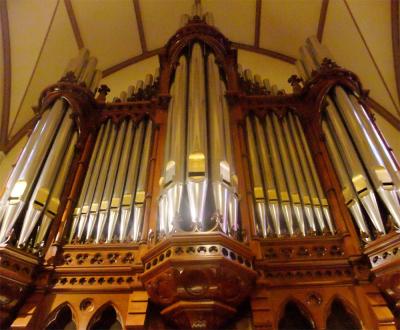
The view of the great case while seated at the console.
The Swell is a splendid division! You see, this is almost completely UNLIKE what I would have expected from Rieger! It's very complete, having three 8' foundation stops, 3 "matching" 4' stops, including a 4' Viola. The reeds are excellent. Here again, one can only long for these in a better acoustical situation. I found the 8' Trompette harmonique to be my "favorite trumpet" on the entire organ. It's almost English in sound, as it has a lot more fundamental than do some of the other trumpets, say for instance the one on the Positive. The strings are good. They're not E. M. Skinner strings, but they are smooth and pleasing, and galaxies away from the "Schwebung" on the Rieger organ that I described having to play, which always reminded me of an out-of-tune flute, which I guess is what it actually was! ;-) The Hautbois is colorful. and decidedly French, although I did manage to use it successfully in the "Trumpet Tune" by Carson Cooman, and extensively in the Howells work.
The Pedal is a solid one. I was pleasantly surprised to find a 16' Wood Diapason present, in addition to another metal one. This 16' Open Wood MAY have been from a previous organ, although perhaps it is also a Rieger work, is it does not have the reel "boom and roll" that those wonderful old English ones have! Still, it worked very nicely, and I got a lot of usage out of it! The reeds are once again "heavy" on the French influence (to match the Great), but not so raucous that they can only be used for Dupre or Tournemire! The upper work certainly completes the Pedal chorus well, but it's big, and could "come through" too much if not properly managed, or if you are obsessed with always using the Great to Pedal coupler.
The Echo division is a complete division in the rear gallery. I'm SURE that it is needed to support congregational singing, and it does have a presence to it. It's really just a "hymn-playing division" though, so, you won't be doing any "dramatic" echo effects on it! However, it could be very useful in "soft" echo usage. The Zimbelstern is also in the rear gallery. To me this is very odd, as I couldn't even hear it "at" the console, until I cranked it up significantly. (Yes, I know this is cheating and non-authentic!) While I'm talking about the Zimbelstern, I have to say that it is just about the "weirdest ring" that I have ever heard on ANY Zimbelstern! After I used it, I could hear the "ringing" for at least an hour, so, use with caution! ;-)
Finally, let's talk about the Trompette royale 8', which is available on most manuals. In my opinion, it's too thin, and almost sounds electronic in the higher registers. I realize that this is a chamade reed and not conceived as an English tuba, but this stop is quite a bit of a let down, and not nearly as thrilling as I was anticipating and hoping that it would be. More fundamental and a wider feel would certainly help this stop.

The Scots' Church Coat of Arms, depicting the flag of St. Andrew, an open Bible, a burning bush,
a stag's head and the Southern Cross constellation.
So, not that we've talked about the organ, let's HEAR what it can do!
The first item that I ask you to listen to is the Magnificat in G Minor by the obscure French composer, Josse-Francois-Joseph Benaut.
Here is the link: https://www.contrebombarde.com/concerthall/music/16939
This work, musically unique, shows just HOW GRAND this organ is for the great French Plein Jeus! Notice also that glorious Harmonic Flute in the Recit! The poor acoustics are not able to defeat this organ in playing the French Baroque literature. The reeds are also fine, but I really thought that, despite the lack of echo, the plein jeu was the star of this piece.
The second item for you to consider is the Trumpet Voluntary in C by the 18th century Englishman, Henry Heron.
Here is the link: https://www.contrebombarde.com/concerthall/music/16940
Here you can listen to the trumpets of the Swell and Great in "dialogue" with one another. Not historically accurate, but the idea is to showcase the organ, right? Notice also, the English smoothness of the opening diapason section. Even with the dry acoustic, this piece works very well, although the lack of echo made me VERY nervous when I was playing it, as NO mistakes, even small ones, can be hidden here!
The next work for your consideration is Vom Himmel hoch, da komm ich her by Johann Pachelbel.
Here is the link: https://www.contrebombarde.com/concerthall/music/16941
Here we get to here the "artificially loudened" Zimbelstern, with its slightly "house of horrors ring of bells"! I suppose I shouldn't say that, as perhaps it will strike other ears as fully pleasant. I think it sounds OK when combined with this music, which I chose carefully, in terms of keys and stops used, to get the best out of the organ and bells combination.
Next we turn to three exquisite preludes from Johannes Brahms' Opus 122. These are combined in order to save "space" on the Concert Hall.
Here is the link: https://www.contrebombarde.com/concerthall/music/16942
The first chorale is the opening one in the collection, Mein Jesu, der du mich, and this is to show the rich and smooth "German romantic" sound of one of "several" plenums available on the organ. This includes the 32' Contrabass and the 16' Bassoon in the Pedal. The second is the fifth in the collection, the lovely Schmucke dich, o liebe Seele, which is played entirely on the Great 8 & 4 flutes. The final one is the last in the collection, the second setting of O Welt, ich muss dich lassen, which demonstrates the richness of the 8-foot sound. Granted, the dryness of the room "works" against it, but you could make romantic literature work on this Rieger if you give a little effort and heart to your playing. Yes, this really IS a Rieger! Of all the demos that I did, I thought that perhaps these preludes came off the best, which was somewhat of a surprise.
Next, we have the brilliant Trumpet Tune by Carson Cooman.
Here is the link: https://www.contrebombarde.com/concerthall/music/16943
Carson's music is so well-conceived that it would work on almost any organ! However, it sounds quite grand on the Scots Rieger. I won't dwell on "criticizing" the Trompette royale", as I've already talked about it above. I will say again that, even though this is a chamade and not a tuba, the dryness of the acoustic DEMANDS a fuller, rounder, more fundamental sound from this. It probably also needs to be a little "louder", since the acoustic fights it on every toot of sound.
Next we come to the "unexpected" inclusion of Guilmant's transcription of Le cygne (The Swan) by Camille Saint-Saens.
Here is the link: https://www.contrebombarde.com/concerthall/music/16944
Once again, I included this to show the organ. It was hard to really make this entirely pleasing, as the atmosphere created by 4 seconds of echo is missing, but I think I came "close enough" to accomplishing what I set out to do with this. The acoustic really makes it tough to get the "feel" on this one, but it's a great learning tool, as you can actually HEAR the notes being played! I confess that I think I had "faked" a few notes in past performances of this piece, and had to "get 'em right" for this recording!
The next item on the menu is the mystical and mighty, Siciliano for a High Ceremony by Herbert Howells. I confess that this one took the most time to get right! The mystical, "incensey atmosphere" of Howells really needs reverberation, but, I wanted to see if I could make this work.
Here is the link: https://www.contrebombarde.com/concerthall/music/16945
The time spent was not so much in choosing the registrations to be used, but to get things to come together in a seamless blend. I never really accomplished what I wanted, but I think it shows that music such as this can really work well on a big Rieger. Earlier I mentioned the Rieger organ at Christ Church, Oxford, which dates from 1979. While Christ Church does not have the best acoustic for an English cathedral, it is certainly FAR more resonant than the Scots' Church. However, if I had to choose the "better" of the two organs, I would choose the Scots Rieger above the one at Oxford. St. Giles Cathedral, Edinburgh also has a big Rieger, which dates from 1992, and I certainly would choose Scots' over that one.
Finally we come to the Grand Choeur in E-flat, composed by Charles-Alexis Chauvet.
Here is the link: https://www.contrebombarde.com/concerthall/music/16946
This rather "straight-forward" item shows the grand sound of the full organ. Certainly we would like for the sound to "roll down the nave" when we release the last chord, but I found a surprising appeal in the "crispness" of the dry acoustical setting. I found that the more I played this, and all the music, the more "natural" it felt, and my "resistance" to the acoustic diminished.
There is a "distance locator," so that you can decide where you want to "listen" from. Generally speaking, I prefer my listening point to be mid to far in perspective of where the sound is coming from. However in this case, I found that the "best" place to listen from was at the very "central crossing". By this I mean, if you think of the shape of the cross, and put an "X" right in the very middle of the intersecting arms, THAT would be my preferred spot. I found it VERY unsatisfactory to listen further down the nave towards the rear, because you really are hearing the organ from "around the corner," and a very big amount of the sound is lost. I have to wonder how this all works and sounds with a large congregation present, but in the "real" situation, I suppose that it does. Or perhaps the rear seats are reserved for people who don't like organ music... ;-)
The on-screen graphics are very nice, and Inspired Acoustics has done a fine job with the fully functioning console, etc. You have several "views" to select from, and everything was very easy to understand, and worked perfectly without any glitches that I could detect.

Scots' at night.
So, now that we've looked at just about everything we can look at, with the exception of the Walze (crescendo pedal), it's time to sum up my perhaps too many thoughts!
Do I like the organ? Yes, I do. I wasn't sure that I would, but the organ itself is excellent. It's smoother and more versatile than I expected, and there are quiet stops that are real masterpieces of construction. As I've said already many times, the biggest drawback of the sample set is the very dry acoustic. It can be dangerous to put a big organ in a "dead" room, but THIS one works - although it comes down to taste and preference.
Should you buy this organ? Naturally, that is the decision of the individual organist. However, I can state several strong reasons that should cause you to give some serious thought to purchasing this sample set. 1) The size and quality of the instrument itself. 2) The value of using this as a "test instrument" for yourself. Although this organ is far more than a "practice organ," it serves the value of learning how to play and manage a big organ in a small acoustic. You can't hide your mistakes here, as ANY of them will show! If you want to make registration changes, you have to be smooth, or it will sound "careless", as I found out in a piece like the Howells "Siciliano". 3) At the cost of $629 for the Personal Edition (full instrument) and $399 for the Medium Edition, the cost is quite decent. 4) As I understand it, a "wet edition" is soon to be released, which, assuming you're not obsessed with absolute "realism", which would solve the acoustical issues, and make you smile wondering how grand this could sound in a better space.
I hope that my review will encourage you to look this organ over carefully. If this doesn't suite your taste, Inspired Acoustics has a number of fine sample sets, the one featuring the organ at Heppenheim seemed to be a real gem!
How can I make my reviews better? Is there some thing or format that I could do that would be more helpful? Did you like the idea of the "demo recital" as part of the review?
Please feel free to comment, to leave feedback, or to make suggestions!
I will close my review with words by John Maidment, chairman and co-founder of the Organ Historical Trust of Australia.
It is for the many who will come to know, and love, this handsome organ, learning its personality, versatility, and many strengths, that this effort of ours, at times bordering on discouragement, and even despair, has been made, and is considered more than worthwhile. From that first rain-swept Wednesday afternoon in September 2010 to the present, the journey has been indeed long and difficult, ever-beset with new obstacles, each requiring fresh energy and innovative action. It will be the greatest of all compliments to our extended, collaborative labour if, in the rapturous enjoyment of the instrument's beauty and power, the manifold facts of this tangled tale amount â for the player steeped in the moment of intrepid practice, or fervent performance, or idle improvisation â to not more than of academic interest, paling under the force of the final result. For those of us who tackled directly this most determined foe, in all the vicissitudes of that conquest, the frustrations and anxieties, while not entirely forgotten, have assumed an inconsequentiality akin to the mother's pains in bringing forth her most dearly beloved child. For that child, now in the hands of a world-wide community of like-minded souls, and for her many new, adoring parents, we wish all success in their future together.
Comments
It's so sad the church commitee decided in favor of carpet and other sound absorbing items rather than allow the magnificence of this instrument to really shine. Who knows, maybe in another generation things might shift in favor of the organ.
It's good to hear there are plans for a wet version of the sample set. I, for one, make too many mistakes and need some "cover" ... but then the sound is also so much more magnificent with a decent amount of reverb.
It does make me think of the organ at the Methuen Memorial Music Hall here in Massachusetts, which would be at the opposite end of the spectrum. The hall was specifically designed and built for the organ, but the reverberation was just too much. In order to reduce it to a reasonable amount they had to hang decorative carpets on the walls. Even with this correction I was extremely disappointed at one concert, where I was so looking forward to hearing the Bach/Vivaldi "Concerto in A minor", and they announced another piece was being substituted. When I asked the guest organist what happened, she said the reverberation was throwing off her timing. That was probably because from the organist's location the sound goes directly up to the extremely high ceiling and back down to the console.
-Jim
Percy Whitlock 1903-1946
Fanfare (07:45) 09:18:37
Peter King, organ Klais 1997, Bath Abbey, Bath GB
http://www.contrebombarde.com/concerthall/music/16280
QUOTE from Joseph Felice jcfelice88keys (03/06/15) Edited
Actually, there IS added reverberation to this performance: I happen to use two algorithmic reverbs in series with one another. Firstly, I add Quik-Quak's Fusion's concert hall preset modified by reducing the high frequencies; next, this sound is fed into Acon Digital Reverberate ($99 USD -- I am not affiliated with either reverb vendor, nor am I on Inspired Acoustics' payroll), in which case I raise the level of the reverb and reduce the level of the direct sound.
I must confess that the review gave me much more pleasure than the sample set itself. I never managed to like this set, despite many trials and because of the ingratious acoustics. I use it quite rarely and only as a working-unforgiving set when I feel some need to crucify myself :-) It's very frustrating to feel that you have a good organ there but that the acoustics spoils it almost completely.
BUT, I must add that your review gave me the envy to load and explore it again, and I am quite impatient to see the release of a wet version, provided it remains at a reasonable price for the owners of the original version.
Thanks for this comprehensive and candid review.
Just a note for those who might be confused: I am the author of the four-part blog series of articles on The Scots' Church Rieger virtual organ, and one of those directly involved in the sampling/documentation effort. John Maidment indeed provided full permission for quoting his material on the history of the church and its organs, as noted in Part One of the blog.
I hope this clears up any confusion.
Cheers,
Stephen A. Phillips.
P.S. Reproducing the organ in a 'larger' acoustic produces VERY GRAND results. I have some small demos exhibiting this on DropBox, linked at the Hauptwerk forum. Anyone wishing fresh links to these short demos, please say so.
Perhaps I should have gotten permission before reproducing John Maidment's comments.
I'm sure it does produce some spectacular sounds in the "larger" space. It would be great if you could post these links for us.
With thanks and best regards,
David Lamb
I would think that your quoting already-approved material presents no issue of permission. John had no objection whatsoever, in any case, and the blog material does acknowledge the original source, as he requested.
I uploaded both WAV and hi-bit-rate mp3 files of the individual stop and plenum sounds of the divisions of The Scots' Rieger, to Dropbox.
Here are the links for the mp3 demos:
https://www.dropbox.com/sh/s5rbpdaoibhz0ee/AABnmQ8K3l1Fty41g1g_8u20a?dl=0
https://www.dropbox.com/sh/xvw1i3db0qvsjxz/AAA8U4eWl3WkBB_jHGS_pdKUa?dl=0
https://www.dropbox.com/sh/9in4qlsa8wrt2ud/AAAMd0YanAaSbGp8aducQAwma?dl=0
https://www.dropbox.com/sh/cru2u03ci8uipwb/AAB4hBaDMiBhHXvgJybgSpkaa?dl=0
https://www.dropbox.com/sh/0bbjlk40yt0joqe/AACqH8wWhj4YUvUnfAV0jKUKa?dl=0
and a snapshot of the unavoidably elaborate set-up I employed to render the extra-reverb performances:
https://www.dropbox.com/s/ctrb1q9m2fv5v1l/Demo%20setup.JPG?dl=0
The demos are really just little improvisations, fashioned in response to the colours of the various ranks and combinations. I hope they prove useful.
Cheers,
Stephen.